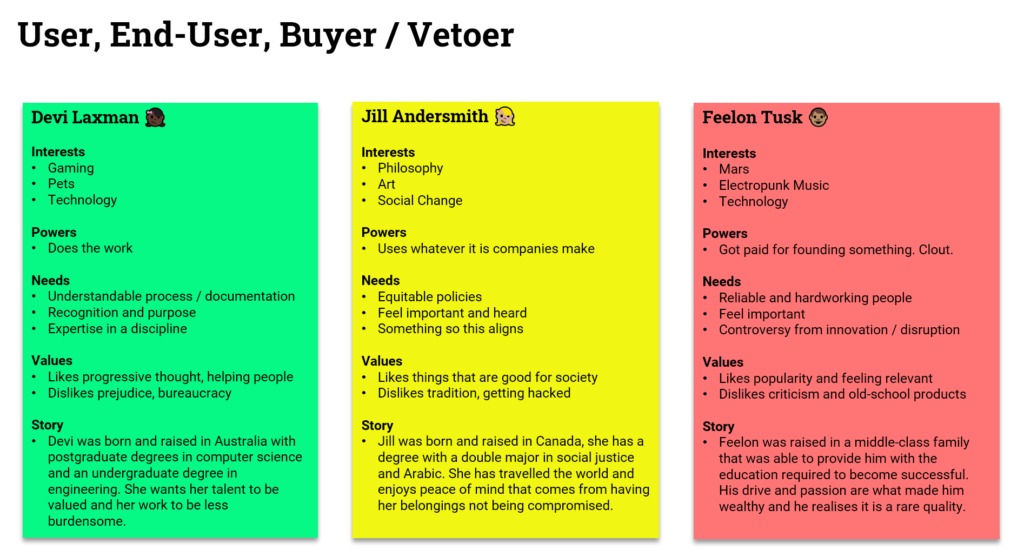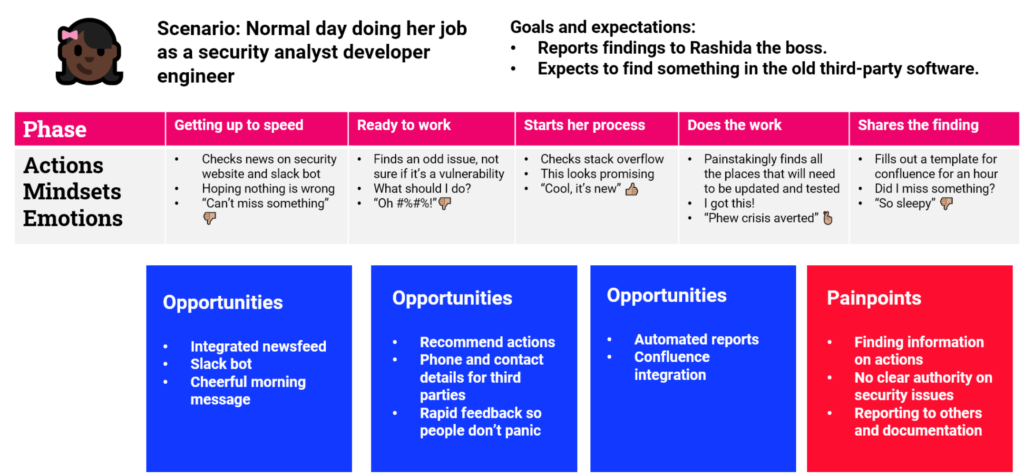Hi,
As a product manager I’ve always encouraged my team to create personas. Creating personas for users is crucial and even customary, but they are also helpful to better understand the entire decision-making unit. If you aren’t familiar with the DMU it mainly consists of influencers, buyers, users and decision-makers. Sometimes it is useful to add end-users when the users of your products are not the end-users. The others ones are fluff.
Next time you’ve been tasked to propose new features or improve current ones I challenge you to review your current personas or update their templates in a matter that forces critical thinking about value creation and finding moments to delight users.
How to update personas?
Keep it simple silly (KISS) ?. Sometimes it helps to remove all the additional information a template might force you into filling out. If you’ve spoken to enough people, which is a desirable trait in a product manager then you should be able to figure out these:
- Interests: What does the user find interesting?
- Powers: What resources does the user control?
- Needs: What does the user need to achieve their goals?
- Values: What does the user find meaningful or frustrating?
- Story: Something you make up that represents an average of demographic, psychographic and behavioural segmentation.
Yes, you can add personality traits, type a random number for income, sources of information and preferred channels of communication but don’t. I’ll make your life easy and tell you now that their story should give you enough information about all the other random things you can add.
What should the persona look like?
Instead of finding the perfect picture use an emoji. The Unicode Consortium has done an adequate job at representing whoever it is that needs a pictorial representation. If their representations are not inclusive enough I am passionate about sending them feedback here: https://unicode.org/emoji/proposals.html
Nana 👵
Brown person 👱🏾♂️
Female farmer 👩🏻🌾
Same sex couple and their children 🧑🧑🧒
Scientist 👩🔬
Child 👶
etc.
Simplification is a struggle for most people, create a table with dot points apart from the story. People who have a background in UX have probably heard of aesthetic-usability effect, it states pretty things are perceived to work better. Spend a few minutes into making it pretty.
Personas with an example
It’s hard to create personas without thinking about a product. We will pick BlackBerry Jarvis (NYSE: BB). A tool that uses binary scanning to help users find vulnerabilities in their codebase. I’ll pick a few people from the decision-making unit for this example.

By reading the persona we can find what would create value by looking at Needs although it will need to be verified by qualitative research. How to advertise and distribute the product can be hypothesized using the other fields but it should be quantitatively and qualitatively verifiable.
Devi, a User requires BlackBerry Jarvis to provide her easy documentation, perhaps rapid feedback as she uses the API. An expertise certificate if she is able to complete a short online test would delight her.
Customer journey using personas
If you’re able to find a persona that is willing to speak to you for a meagre fee, a coffee or a free trial then I recommend speaking with them. For new products using quantitative information or data collected by your analytics suite might not be enough. If possible ask about their day and take some creative leaps into making their current journey, which you want to improve with the help of your UX team to an ideal journey later.
When creating a journey I prefer to highlight opportunities and pain points for each step. A good journey template can be found here: https://media.nngroup.com/media/articles/attachments/JMTemplate.pdf

We can see Devi uses slack a lot so a slack integration might help her need for quick feedback and process related communication. Including information that is not in the scope of a security tool such as contact information for a third party library that has vulnerabilities would save her time and delight her. Automating a lot of reporting tasks she undertakes will give her more time to be creative and innovative.
Wasn’t that simple?
A lot of product management processes can be simple but it requires communicating with users and staying on top of research and data. Coming up with marketable ideas using a simple process and uncovering hidden needs requires a lot of creativity. Having good communication skills and the ability to make engaging presentations is key to convincing your internal stakeholders and talking to users. So use a lot of simple tools to make life easier and spend that extra time to hone your research and communication skills.
What you learned
- How to create a simple persona
- How to make a simple journey
- Concentrating on what creates value
- Find opportunities and pain points in every conversation you have with customers
Keep talking to your users, you’ll do okay.
